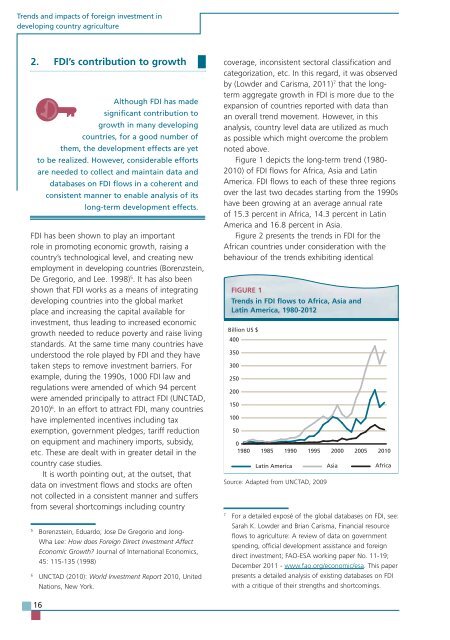TRENDS AND IMPACTS OF FOREIGN INVESTMENT IN DEVELOPING COUNTRY AGRICULTURE
TRENDS AND IMPACTS OF FOREIGN INVESTMENT IN DEVELOPING COUNTRY AGRICULTURE
TRENDS AND IMPACTS OF FOREIGN INVESTMENT IN DEVELOPING COUNTRY AGRICULTURE
Create successful ePaper yourself
Turn your PDF publications into a flip-book with our unique Google optimized e-Paper software.
Trends and impacts of foreign investment in<br />
developing country agriculture<br />
2. FDI’s contribution to growth coverage, inconsistent sectoral classification and<br />
categorization, etc. In this regard, it was observed<br />
by (Lowder and Carisma, 2011) 7 that the long-<br />
Although FDI has made<br />
significant contribution to<br />
growth in many developing<br />
countries, for a good number of<br />
them, the development effects are yet<br />
to be realized. However, considerable efforts<br />
are needed to collect and maintain data and<br />
databases on FDI flows in a coherent and<br />
consistent manner to enable analysis of its<br />
long-term development effects.<br />
FDI has been shown to play an important<br />
role in promoting economic growth, raising a<br />
country’s technological level, and creating new<br />
employment in developing countries (Borenzstein,<br />
De Gregorio, and Lee. 1998) 5 . It has also been<br />
shown that FDI works as a means of integrating<br />
developing countries into the global market<br />
place and increasing the capital available for<br />
investment, thus leading to increased economic<br />
growth needed to reduce poverty and raise living<br />
standards. At the same time many countries have<br />
understood the role played by FDI and they have<br />
taken steps to remove investment barriers. For<br />
example, during the 1990s, 1000 FDI law and<br />
regulations were amended of which 94 percent<br />
were amended principally to attract FDI (UNCTAD,<br />
2010) 6 . In an effort to attract FDI, many countries<br />
have implemented incentives including tax<br />
exemption, government pledges, tariff reduction<br />
on equipment and machinery imports, subsidy,<br />
etc. These are dealt with in greater detail in the<br />
country case studies.<br />
It is worth pointing out, at the outset, that<br />
data on investment flows and stocks are often<br />
not collected in a consistent manner and suffers<br />
from several shortcomings including country<br />
5 Borenzstein, Eduardo; Jose De Gregorio and Jong-<br />
Wha Lee: How does Foreign Direct Investment Affect<br />
Economic Growth? Journal of International Economics,<br />
45: 115-135 (1998)<br />
6 UNCTAD (2010): World Investment Report 2010, United<br />
Nations, New York.<br />
16<br />
term aggregate growth in FDI is more due to the<br />
expansion of countries reported with data than<br />
an overall trend movement. However, in this<br />
analysis, country level data are utilized as much<br />
as possible which might overcome the problem<br />
noted above.<br />
Figure 1 depicts the long-term trend (1980-<br />
2010) of FDI flows for Africa, Asia and Latin<br />
America. FDI flows to each of these three regions<br />
over the last two decades starting from the 1990s<br />
have been growing at an average annual rate<br />
of 15.3 percent in Africa, 14.3 percent in Latin<br />
America and 16.8 percent in Asia.<br />
Figure 2 presents the trends in FDI for the<br />
African countries under consideration with the<br />
behaviour of the trends exhibiting identical<br />
FIGURE 1<br />
Trends in FDI flows to Africa, Asia and<br />
Latin America, 1980-2012<br />
Billion US $<br />
400<br />
350<br />
300<br />
250<br />
200<br />
150<br />
100<br />
50<br />
0<br />
1980<br />
1985<br />
1990<br />
1995<br />
Latin America Asia Africa<br />
Source: Adapted from UNCTAD, 2009<br />
2000<br />
2005<br />
2010<br />
7 For a detailed exposé of the global databases on FDI, see:<br />
Sarah K. Lowder and Brian Carisma, Financial resource<br />
flows to agriculture: A review of data on government<br />
spending, official development assistance and foreign<br />
direct investment; FAO-ESA working paper No. 11-19;<br />
December 2011 - www.fao.org/economic/esa. This paper<br />
presents a detailed analysis of existing databases on FDI<br />
with a critique of their strengths and shortcomings.


